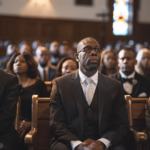|
Listen to this article
Getting your Trinity Audio player ready...
|
In the tapestry of human history, expressions of faith and worship have always held a special place. From the ancient sands of the Sinai desert to modern-day church pews, the fervor and intensity of worship have manifested in various forms. Two such powerful expressions are Miriam’s dance as recorded in the Book of Exodus and the dynamic shout and quickening seen in contemporary African American gospel traditions, epitomized by gospel legend Shirley Caesar.
Miriam’s Dance: A Celebration of Deliverance
The story of Miriam’s dance is found in Exodus 15:20-21. After the miraculous crossing of the Red Sea, Miriam, the sister of Aaron, led the women of Israel in a triumphant dance:
“And Miriam the prophetess, the sister of Aaron, took a timbrel in her hand; and all the women went out after her with timbrels and with dances. And Miriam answered them, Sing ye to the Lord, for he hath triumphed gloriously; the horse and his rider hath he thrown into the sea” (Exodus 15:20-21, KJV).
Miriam’s dance, described with the Hebrew word “machol” (מָחוֹל), signifies a round dance, a common form of celebration in ancient Israelite culture. This dance was not just a spontaneous outburst but a communal, rhythmic expression of joy and gratitude towards God for His mighty act of deliverance. It symbolized unity, shared faith, and the collective experience of God’s salvation.
Shirley Caesar’s Shout and Quickening: Contemporary Echoes of Ancient Joy
Fast forward several millennia, and we find similar expressions of joy and spiritual ecstasy in the African American gospel tradition. Shirley Caesar, a towering figure in gospel music, is known for her exuberant worship style, often characterized by what is termed as “shouting” and “quickening.”
Shouting in this context does not refer to loud vocal expressions alone but encompasses a form of dance and physical movement. It involves rhythmic, spirited movements, often resembling hopping or skipping, reflecting an overflow of joy and spiritual excitement.
Quickening refers to a moment of intense spiritual arousal, where the worshiper feels an overwhelming presence of the Holy Spirit, leading to spontaneous movements, shouts, or speaking in tongues. This quickening is a deeply personal and intense experience, often occurring in communal worship settings where the collective spirit of the congregation amplifies individual expressions of faith.
Similarities: Timeless Joy and Communal Celebration
- Expression of Joy: Both Miriam’s dance and Shirley Caesar’s shout are forms of expressing profound joy and gratitude towards God. They are spontaneous, heartfelt, and reflect a deep spiritual connection.
- Communal Experience: Miriam led all the women of Israel in her dance, creating a shared experience of worship. Similarly, shouting and quickening often occur in the communal setting of a church service, where the collective spirit enhances individual expressions of worship.
- Musical Accompaniment: Music plays a central role in both traditions. Miriam’s dance was accompanied by timbrels and singing, just as modern gospel shouting is often accompanied by exuberant gospel music.
Differences: Cultural and Contextual Variations
- Cultural Context: Miriam’s dance is rooted in ancient Hebrew tradition and the specific historical context of the Exodus. In contrast, Shirley Caesar’s expressions are part of the African American gospel tradition, which has evolved within a different historical and cultural framework.
- Form and Style: Miriam’s dance was likely more structured and choreographed, reflecting the communal dances of ancient Israel. Shouting and quickening, on the other hand, are more spontaneous and less structured, reflecting personal encounters with the Holy Spirit.
- Purpose and Setting: Miriam’s dance was a response to a specific historical event—God’s deliverance of Israel from Egypt. Shouting and quickening occur regularly within worship services, responding to the ongoing experience of God’s presence.
The Continuity of Worship
Despite the differences in cultural and historical contexts, the core elements of these worship expressions—joy, communal celebration, and musical accompaniment—highlight the continuity of human expressions of faith. They underscore how, across different eras and cultures, people have found powerful ways to express their gratitude and joy towards God.
Reflecting on Worship Today
As we reflect on these expressions of worship, we see that they serve more than just a celebratory purpose. They are acts of faith, communal bonds, and reminders of God’s continual presence and deliverance in the lives of His people. Whether through the structured dances of ancient Israel or the spirited shouts of modern gospel services, these acts of worship remind us of the timelessness of joy in God’s salvation.
Conclusion
Through the lens of Miriam’s dance and Shirley Caesar’s shout, we witness the enduring power of joyous worship. These expressions of faith, though separated by time and culture, reflect a shared human desire to celebrate and thank God. They remind us that worship is not confined to words alone but encompasses the full range of human emotion and physical expression.
These forms of worship encourage us to look beyond our immediate cultural practices and appreciate the rich diversity of ways in which believers throughout history have connected with the divine. By doing so, we can deepen our own worship experiences and foster a greater sense of unity within the body of Christ.
For Churchdox, this exploration into the historical and cultural dimensions of worship can serve as a bridge, connecting contemporary believers with their spiritual heritage and inspiring a more profound and inclusive approach to worship today.







